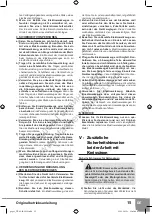
4
TK 65 • TK 85
EN
III - Safety rules for laser
lights
The laser light/laser radiation used in the SPARKEYE
®
system is Class 2 with maximum power ≤1 mW and
650 nm wavelength.
These lasers do not normally present an optical hazard,
although staring at the beam may cause flash blindness.
WARNING:
Do not stare directly at the laser
beam. A hazard may exist if you deliberately stare into the
beam.
Please observe all safety rules as follows:
▪
The laser shall be used and maintained in accordance
with the manufacturer’s instructions.
▪
Never aim the beam at any person or an object other
than the work piece.
▪
The laser beam shall not be deliberately aimed at
personnel and shall be prevented from being directed
towards the eye of a person.
▪
Always ensure the laser beam is aimed at a sturdy
work piece without reflective surfaces i.e. wood or
rough coated surfaces are acceptable. Bright shiny
reflective sheet steel or the like is not suitable for laser
use as the reflective surface could direct the beam
back at the operator.
▪
Do not change the laser light assembly with a different
type. Repairs must only be carried out by the laser
manufacturer or an authorized agent.
WARNING:
Use of controls or adjustments or
performance of procedures other than those specified
herein may result in hazardous radiation exposure.
IV - General power tool
safety warnings
WARNING!
Read all safety warnings and
all instructions. Failure to follow the warnings and
instructions may result in electric shock, fire and/or
serious injury.
Save all warnings and instructions for future
reference.
The term “power tool” in the warnings refers to your
mains-operated (corded) power tool or battery-operated
(cordless) power tool.
1. WORK AREA SAFETY
a) Keep work area clean and well lit. Cluttered or
dark areas invite accidents.
b) Do not operate power tools in explosive atmos-
pheres, such as in the presence of flammable
liquids, gases or dust. Power tools create sparks
which may ignite the dust or fumes.
c) Keep children and bystanders away while oper-
ating a power tool. Distractions can cause you to
lose control.
2. ELECTRICAL SAFETY
a) Power tool plugs must match the outlet. Never
modify the plug in any way. Do not use any
adapter plugs with earthed (grounded) power
tools. Unmodified plugs and matching outlets will re-
duce risk of electric shock.
b) Avoid body contact with earthed or grounded
surfaces, such as pipes, radiators, ranges and
refrigerators. There is an increased risk of electric
shock if your body is earthed or grounded.
c) Do not expose power tools to rain or wet condi-
tions. Water entering a power tool will increase the
risk of electric shock.
d) Do not abuse the cord. Never use the cord for
carrying, pulling or unplugging the power tool.
Keep cord away from heat, oil, sharp edges or
moving parts. Damaged or entangled cords in-
crease the risk of electric shock.
e) When operating a power tool outdoors, use an
extension cord suitable for outdoor use. Use of a
cord suitable for outdoor use reduces the risk of elec-
tric shock.
f) If operating a power tool in a damp location
is unavoidable, use a residual current device
(RCD) protected supply. Use of an RCD reduces
the risk of electric shock.
3. PERSONAL SAFETY
a) Stay alert, watch what you are doing and use
common sense when operating a power tool. Do
not use a power tool while you are tired or under
the influence of drugs, alcohol or medication.
A moment of inattention while operating power tools
may result in serious personal injury.
b) Use personal protective equipment. Always
wear eye protection. Protective equipment such as
dust mask, non-skid safety shoes, hard hat, or hear-
ing protection used for appropriate conditions will re-
duce personal injuries.
c)
Prevent unintentional starting. Ensure the
switch is in the off-position before connecting
to power source and/or battery pack, picking up
or carrying the tool. Carrying power tools with your
finger on the switch or energising power tools that
have the switch on invites accidents.
d) Remove any adjusting key or wrench before
turning the power tool on. A wrench or a key left
attached to a rotating part of the power tool may result
in personal injury.
e) Do not overreach. Keep proper footing and bal-
ance at all times. This enables better control of the
power tool in unexpected situations.
f) Dress properly. Do not wear loose clothing or
jewellery. Keep your hair, clothing and gloves
pages_TK 65-85-2012.indd 4
22.11.2012 г. 11:41:42 ч.
Та
ше
в
-
Га
лв
ин
г
ОО
Д
www.tashev-galving.com







































